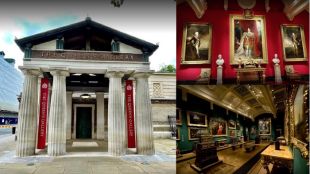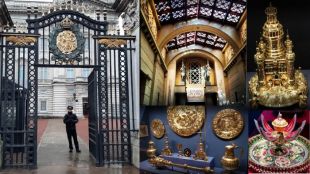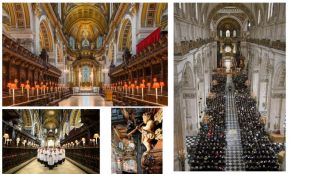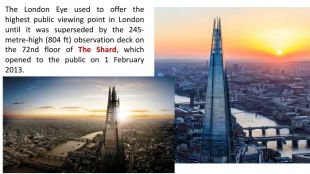Презентація "Sights of London"




































Trafalgar Square is the central square of London and traditional place for people to meet. In 1830 the area was named Trafalgar Square after the Battle of Trafalgar, a British naval victory in the Napoleonic Wars with France and Spain that took place on 21 October 1805. It is a centre of national democracy and protest. Rallies and demonstrations are frequently held at weekends on different political, religious and general issues. The Mayor supports this democratic tradition, and gives access to the square for such causes.
From the 14th to the 17th century, the Square was the site of the King’s Mews (stables) that served Whitehall Palace. After King George IV moved the mews to Buckingham Palace, John Nash, a leading architect of that time, began redevelopment of the area in 1812. John Nash died soon after construction started and progress slowed thereafter. Plans laid by the second architect, William Wilkins (who designed the National Gallery), were never actioned. In 1840, the third architect, Charles Barry, who rebuilt the Houses of Parliament, submitted plans that were accepted and construction resumed. The Square then opened in 1844.
A number of commemorative statues occupy the Square. First is Nelson’s Column. Built between 1840 and 1843, the Column stands 52m tall in the middle of the square, was designed by William Railton and carved out of Craigleith sandstone by the Briston-born sculptor Edward Baily. It commemorates Admiral Horatio Nelson who died in the Battle of Trafalgar in 1805. Bronze reliefs on its pedestal installed in 1849 depict scenes from Nelson’s most famous battles; the metal used to carve them came from French guns which had been captured and melted down.
Along the wall of the north end of the square (in front of the National Gallery) are three busts of admirals. One is of Lord John Jellicoe who fought in the Anglo-Egyptian war and which was erected in 1948. Also erected in 1948 was the bust of the Admiral of the Fleet Lord David Richard Beatty who fought in the Madhist War between the Sudanese and Egyptians. The third is of Sea Lord Admiral of the Fleet Andrew Browne Cunningham, a senior officer in the Royal Navy during World War II. This was erected in 1967. Морський лорд-адмірал. Ендрю Браун Каннінгем. Лорд Джон Джелліко. Адмірал флоту Девід Річард Бітті, 1-й граф Бітті
The National Gallery is an art museum in Trafalgar Square in the City of Westminster, in Central London. Founded in 1824, it houses a collection of over 2,300 paintings dating from the mid-13th century to 1900. The Gallery is an exempt charity, and a non-departmental public body of the Department for Digital, Culture, Media and Sport. Its collection belongs to the government on behalf of the British public, and entry to the main collection is free of charge. In 2020, due to the COVID-19 pandemic it attracted only 1,197,143 visitors, a drop of 50 per cent from 2019, but it still ranked eighth on the list of most-visited art museums in the world.https://www.nationalgallery.org.uk/ https://artsandculture.google.com/partner/the-national-gallery-london
https://artsandculture.google.com/streetview/the-national-gallery/hg. FGlzj1 Gi. Nx. Tg?sv_lng=-0.1292670827492088&sv_lat=51.50882091057702&sv_h=325.44547761314067&sv_p=-1.0799683588700901&sv_pid=3 F8 KEQFl24_17zo. Ztetf-Q&sv_z=1 Посилання на ОГЛЯД Національної галереї в Лондоні онлайн:
Tower Bridge is a Grade I listed combined bascule and suspension bridge in London, built between 1886 and 1894, designed by Horace Jones and engineered by John Wolfe Barry with the help of Henry Marc Brunel. The bridge crosses the River Thames close to the Tower of London and is one of five London bridges owned and maintained by the Bridge House Estates, a charitable trust founded in 1282. The bridge was constructed to give better access to the East End of London, which had expanded its commercial potential in the 19th century. The bridge was opened by Edward, Prince of Wales and Alexandra, Princess of Wales in 1894.
London Bridge. Tower Bridge. Tower Bridge has become a recognisable London landmark. It is sometimes confused with London Bridge, about 0.5 miles (0.80 km) upstream, which has led to a popular urban legend about an American purchasing the wrong bridge. Several stunt pilots have flown underneath the bridge, including the pioneering Francis Mc. Clean.
Buckingham Palace is a London royal residence and the administrative headquarters of the monarch of the United Kingdom. Originally known as Buckingham House, the building at the core of today's palace was a large townhouse built for the Duke of Buckingham in 1703 on a site that had been in private ownership for at least 150 years.
Elizabeth II (Elizabeth Alexandra Mary; born 21 April 1926) is the Queen of the United Kingdom and 14 other Commonwealth realms. When her father died in February 1952, Elizabeth—then 25 years old—became queen regnant of seven independent Commonwealth countries: the United Kingdom, Canada, Australia, New Zealand, South Africa, Pakistan, and Ceylon, as well as Head of the Commonwealth. The Queen’s coronation was on the 2nd of June, 1953.
St Paul's Cathedral is an Anglican cathedral in London. The cathedral is one of the most famous and most recognisable sights of London. St. Paul's Cathedral impressed with its grandeur, typical of the Gothic style - 158 metres long and 37 (75 in the widest place) metres wide. The outer height of the dome is 85 metres, the inner height of the dome is 69 metres.
The outer dome diameter is 34 m and the inner diameter is 31 m. The dome remains among the highest in the world. Above the keystones of the arches, at 99 feet (30 m) above the floor and 112 feet (34 m) wide, runs a cornice which supports the Whispering Gallery so called because of its acoustic properties: a whisper or low murmur against its wall at any point is audible to a listener with an ear held to the wall at any other point around the gallery. It is reached by 259 steps from ground level.
The London Eye, or the Millennium Wheel, is a cantilevered observation wheel on the South Bank of the River Thames in London. It is Europe's tallest cantilevered observation wheel, and is the most popular paid tourist attraction in the United Kingdom with over 3 million visitors annually. The structure is 135 metres (443 ft) tall and the wheel has a diameter of 120 metres (394 ft). When it opened to the public in 2000 it was the world's tallest Ferris wheel.
The Palace of Westminster serves as the meeting place for both the House of Commons and the House of Lords, the two houses of the Parliament of the United Kingdom. Informally known as the Houses of Parliament, the Palace lies on the north bank of the River Thames in the City of Westminster, in central London, England.

про публікацію авторської розробки
Додати розробку




































